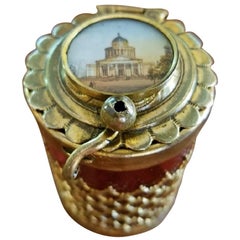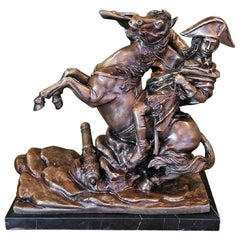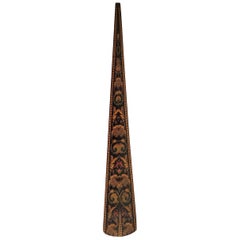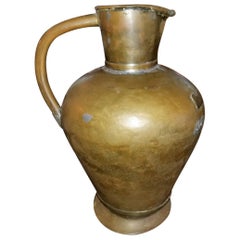Want more images or videos?
Request additional images or videos from the seller
1 of 14
19 Century Indo-Persian Pill Box Featuring a Polo Game
Price:$240
$260List Price
About the Item
- Dimensions:Height: 1 in (2.54 cm)Diameter: 2.5 in (6.35 cm)
- Style:Islamic (Of the Period)
- Materials and Techniques:
- Place of Origin:
- Period:
- Date of Manufacture:1820-1840
- Condition:Wear consistent with age and use. Very good original condition.
- Seller Location:Dallas, TX
- Reference Number:1stDibs: LU3978114246921
About the Seller
4.9
Gold Seller
Premium sellers maintaining a 4.3+ rating and 24-hour response times
Established in 2015
1stDibs seller since 2018
395 sales on 1stDibs
Authenticity Guarantee
In the unlikely event there’s an issue with an item’s authenticity, contact us within 1 year for a full refund. DetailsMoney-Back Guarantee
If your item is not as described, is damaged in transit, or does not arrive, contact us within 7 days for a full refund. Details24-Hour Cancellation
You have a 24-hour grace period in which to reconsider your purchase, with no questions asked.Vetted Professional Sellers
Our world-class sellers must adhere to strict standards for service and quality, maintaining the integrity of our listings.Price-Match Guarantee
If you find that a seller listed the same item for a lower price elsewhere, we’ll match it.Trusted Global Delivery
Our best-in-class carrier network provides specialized shipping options worldwide, including custom delivery.You May Also Like
19th Century Indo-Persian Dhal Separ Steel Shield
Located in Redding, CT
19th Century Indo-Persian Dhal Separ Steel Shield . Intricate decorative design with Brass inlay. Convex steel and iron shield with gold inlay and applied...
Category
Antique Early 19th Century Anglo-Indian Arms, Armor and Weapons
Materials
Metal, Brass, Steel, Iron
Late 19th Century English Game Box
Located in Casteren, Noord-Brabant
Lovely antique game box, made of mahogany.
The box contains several games, with many bits and pieces. Not all complete.
It is obviously that there h...
Category
Antique 1890s British Belle Époque Games
Materials
Wood
Indo Persian Steel and Brass Khula Khud Helmet
Located in Moreno Valley, CA
Indo Persian steel and brass Khula Khud Helmet.
Central Asia, Indo-Persian culture, circa early 20th century.
A fine hammered metal steel and brass Islamic khula khud helmet of a domed form with an additional brass top finial.
The top features radiating striations etched across the exterior and a tall brass spike finial with hammered line the lower periphery of the helmet, and a contiguous swath of chain mail hangs down to protect the wearer's neck.
Dimensions: 22 in height total x 8 diameter.
top hat is 8 in. x 7 in h to top finial.
Metal base is 6.5 in. x 6.5 in.
Indo Persian reproduction of an antique Islamic Helmet...
Category
Vintage 1930s Indian Islamic Arms, Armor and Weapons
Materials
Metal
Wood and leather game box - Italy, 19th century
Located in Bruxelles, BE
Wood and leather game box for chess, Nine men’s morris and Backgammon
Italy, 19th century
33 x 33,3 x 11,2 cm
Nine men’s morris also known as mill game (merelles, from the Latin wor...
Category
Antique 19th Century Italian Arts and Crafts Games
Materials
Leather, Wood
Antique Indo Persian Dhal Separ Shield
Located in Palm Beach, FL
Intriguing historical 19th Century Indo Persian shield handcrafted in steel and decorated with four floral protuberances and engraved figures, reta...
Category
Antique Late 19th Century Indian Moorish Arms, Armor and Weapons
Materials
Steel
19th Century Indo - Portuguese Rosewood Altar
Located in Topanga, CA
This 19th-century Indo-Portuguese altar was masterfully crafted from rich rosewood and crowned with a beautifully carved crosses at the top. This exceptional piece exemplifies the ha...
Category
Antique 19th Century Indian Other Religious Items
Materials
Rosewood
19th Century Indo - Portuguese Rosewood Altar
Located in Topanga, CA
This 19th-century Indo-Portuguese altar was masterfully crafted from rich rosewood and crowned with a beautifully carved cross at the pinnacle. This exceptional piece exemplifies the...
Category
Antique 19th Century Indian Other Religious Items
Materials
Rosewood
19th Century Indo - Portuguese Rosewood Tabernacle
Located in Topanga, CA
This 19th-century Indo-Portuguese tabernacle is masterfully crafted from rich rosewood and crowned with a beautifully carved cross at the pinnacle. This exceptional piece exemplifies...
Category
Antique 19th Century Indian Other Religious Items
Materials
Rosewood
19th Century Game Box - Oak - Chess and Checkers - Dominoes
Located in Casteren, Noord-Brabant
A beautiful antique English games box, including the games chess, checkers and dominoes.
The game box is in good condition and complete. Please note that two black checkers have a sl...
Category
Antique 1890s English Late Victorian Games
Materials
Oak
$592
Free Shipping
H 4.73 in W 13 in D 8.67 in
Threefold Game Box
Located in Paris, FR
Game box threefold with solid wood structure covered with
high quality italian genuine leather., including 3 sets of games:
draughts, domino and chess. Se...
Category
21st Century and Contemporary Italian Games
Materials
Leather, Wood
More From This Seller
View All19th Century Italian Ruby Glass Box with Miniature of Basilica
Located in Dallas, TX
Lovely little 19th century ring jar or pill box made of a thick wine colored ruby glass.
It has a miniature of a Basilica on top, gilt metal mounts with beautiful filigree on the si...
Category
Antique Early 19th Century Vatican Grand Tour Decorative Boxes
Materials
Metal
19th Century Bronze Sculpture of Napoleon Crossing the Alps
Located in Dallas, TX
PRESENTING A LOVELY late 19C Bronze Sculpture of Napoleon Crossing the Alps.
19th Century Bronze of Napoleon on Horseback in Battle, with c...
Category
Antique Late 19th Century French Napoleon III Figurative Sculptures
Materials
Belgian Black Marble, Bronze
Rare 19th Century English Tunbridgeware Hair Pin or Slide
Located in Dallas, TX
PRESENTING an EXTREMELY UNIQUE and RARE 19C British Tunbridgeware Hair Pin/Bobbin or Slide.
This slide is unlike any of it’s kind we have seen before, it is a VERY RARE survivor.
From circa 1860 – 80 and made in Tunbridge Wells, England.
Made of walnut with gorgeous marquetry inlay on the entirety of the front with classic Tunbridgeware micro-mosaic all over the front. The rear is walnut.
The marquetry inlay appears to be various different woods, namely, maple, walnut and satinwood.
Would have been worn in a Lady’s hair bun with the micro-mosaic facing forward.
This would have belonged to a VERY ELEGANT LADY in the mid to late 19th Century.
Tunbridge ware is a form of decoratively inlaid woodwork, typically in the form of boxes, that is characteristic of Tonbridge and the spa town of Royal Tunbridge Wells in Kent in the 18th and 19th centuries. The decoration typically consists of a mosaic of many very small pieces of different coloured woods that form a pictorial vignette. Shaped rods and slivers of wood were first carefully glued together, then cut into many thin slices of identical pictorial veneer with a fine saw. Elaborately striped and feathered bandings for framing were pre-formed in a similar fashion.
There is a collection of Tunbridge ware in the Tunbridge Wells Museum and Art Gallery in Tunbridge Wells.
The famous makers of Tunbridge ware were in the Tunbridge Wells area of Kent; their most notable work was from circa 1830-1900.
Early makers of Tunbridge ware, in Tunbridge Wells in the mid-18th century, were the Burrows family, and Fenner and Co. In the 19th century, around 1830, James Burrows invented a technique of creating mosaics from wooden tesserae. Henry Hollamby, apprenticed to the Burrows family, set up on his own in 1842 and became an important manufacturer of Tunbridge ware, employing about 40 people.
Edmund Nye (1797–1863) and his father took over the Fenner company when William Fenner retired in 1840, after 30 years in partnership with him. Thomas Barton (1819–1903), previously apprenticed at the Wise factory, joined the Nyes in 1836, and worked as Nye’s designer; he took over the business in 1863 and continued there until his death.
In Tonbridge (near to Tunbridge Wells), George Wise (1703–1779) is known to have had a business in 1746. It continued with his son Thomas, and Thomas’s nephew George (1779–1869), who took over in 1806. In its early years the company made articles such as workboxes and tea caddies with prints of popular views; later items had pictures created from mosaics. Their workshop in Tonbridge, Wise’s Tunbridge Ware Manufactory, was next to the Big Bridge over the Medway; the building was demolished in 1886 to widen the approach to the bridge.
Tunbridge ware became popular with visitors to the spa town of Tunbridge Wells, who bought them as souvenirs and gifts. Articles included cribbage boards, paperweights, writing slopes, snuffboxes and glove boxes.
At the Great Exhibition of 1851, Tunbridge ware by Edmund Nye, Robert Russell and Henry Hollamby was shown; Edmund Nye received a commendation from the judges for his work. He exhibited a table depicting a mosaic of a ship at sea; 110,800 tesserae were used in making the picture.
The manufacturers of Tunbridge ware were cottage industries, and they were no more than nine in Tunbridge Wells and one in Tonbridge. The number declined in the 1880s; competent craftsmen were hard to find, and public tastes changed. After the death of Thomas Barton in 1903 the only surviving firm was Boyce, Brown and Kemp, which closed in 1927.
Marquetry was an old technique which was continued by Nye and Barton to create images such as birds or butterflies.
‘Green Oak’ as caused by the fungus Chlorociboria aeruginascens.
Stickware and half-square mosaic was invented by James Burrows in about 1830: a bunch of wooden sticks of different colours, each having triangular or diamond-shaped cross section, were tightly glued together; in the case of stickware, the resulting block was dried, then turned to form an article such as the base of a pincushion. For half-square mosaic, thin slices were taken from the composite block, and applied to a surface.
Tesselated mosaic, was a development by James Burrows of half-square mosaic; it was adopted by George Wise and Edmund Nye. Minute tesserae were used to form a wide variety of geometric and pictorial designs.
Many sorts of wood were used for the various colours; about 40 were in regular use. Only natural colors were used; green was provided by “green oak”, produced by the action of fungus on fallen oak. Designs for articles were often taken from designs of Berlin wool work.
Category
Antique Late 19th Century English High Victorian Collectible Jewelry
Materials
Satinwood, Walnut
19th Century Large Civil War Era Bronze and Tin Pitcher
Located in Dallas, TX
Presenting a fabulous historic treasure of times past, namely, a 19th century large Civil War Era bronze and tin pitcher.
From circa 1850, this is an American frontier piece.
I...
Category
Antique Mid-19th Century American American Classical Pitchers
Materials
Brass, Bronze, Copper, Tin
Saudi Arabian Camel Saddle with Camel Whip
Located in Dallas, TX
PRESENTING a rare Saudi Arabian Camel Saddle with it’s camel whip.
A real conversation piece from the mid-20th Century, circa 1960-1980.
Made of oli...
Category
20th Century Saudi Arabian Islamic Chairs
Materials
Brass
Pair of 18C Middle Eastern Damascene Vases
Located in Dallas, TX
Stunning pair of 18th century Damascene Vases made of solid brass inlaid with copper and pure silver inlay a gorgeous decoration.
Each vase has matchin...
Category
Antique Late 18th Century Jordanian Islamic Vases
Materials
Sterling Silver, Brass, Copper
$1,200 / set
Recently Viewed
View AllMore Ways To Browse
Persian Vessel
Islamic Persian Vase
Pill Vase
Persian Vase Silver
Persian Jar
Persian Silver Box
Antique Persian Silver Box
Antique Jar
Vintage Brown Jar
Glazed Ceramic Jar
Antique Glazed Jar
Antique Chinese Jars
Chinese Jars Antique
Blue And White Porcelain Jars
Terracotta Jars
Antique Lidded Jars
Large Decorative Jar With Lids
Brown Glazed Jar



